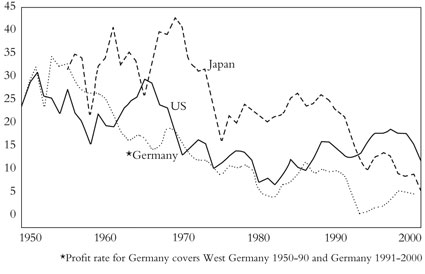
The tendency of the rate of profit to fall (TRPF) is an empirical observation in political economy concerning the overall rate of profit of an economy, which tends to decrease over time. This is subject to discussion in crisis theory. The discussions on the causes of this tendency can be found in Chapter 13 of Karl Marx's Capital, Volume III,[1] but economists as diverse as Adam Smith,[2] John Stuart Mill,[3] David Ricardo[4] and Stanley Jevons[5] referred explicitly to the TRPF as an empirical phenomenon that demanded further theoretical explanation, although they differed on the reasons why the TRPF should necessarily occur.[6] Marx regarded the TRPF as proof that capitalist production could not be an everlasting form of production since in the end the profit principle itself would suffer a breakdown.[7]
This tendency is also a global phenomenon.[8] In 2020, the US rate of profit continued its downward trend, leading to heightened crisis among the profit-seeking class (the bourgeoisie)[9]
See also
References
- ↑ It is also referred to by Marx as the "law of the tendency of the rate of profit to fall" (LTRPF). As explained in the article, there are disputes about whether there is such a law or not. Other terms used include "the falling rate of profit" (FROP), the "falling tendency of the rate of profit" (FTRP), "decline of the rate of profit" (DROP), and the "tendential fall of the rate of profit" (TFRP). The average rate of profit on production capital is usually written as r = S / (C+V).
- ↑ Adam Smith. The Wealth of Nations: '9'. See also Philip Mirowski (1982). Adam Smith, Empiricism, and the Rate of Profit in Eighteenth-Century England.. History of Political Economy, vol.14 (pp. 178–198.).
- ↑ John Stuart Mill (1848). Principles of Political Economy: '4'. Bela A. Balassa (1959). Karl Marx and John Stuart Mill. (pp. 147–165). Weltwirtschaftliches Archiv. Bd. 83
- ↑ David Ricardo. Principles of Political Economy and Taxation: '6'.. Maurice Dobb. The Sraffa system and critique of the neoclassical theory of distribution.. In : E.K. Hunt & Jesse G. Schwartz (1972). A Critique of Economic Theory (pp. 211–213). Penguin.
- ↑ W. Stanley Jevons (1970). The Theory of Political Economy (pp. 243–244). Harmondsworth: Penguin Books.
- ↑ Aspromourgos, Tony. Profits., in: James D. Wright (ed.) (2015, 2nd edition). International Encyclopedia of the Social & Behavioural Sciences, vol. 19. Amsterdam: Elsevier.
- ↑ Karl Marx (1981). Capital, Volume III (pp. 350 and 368). Penguin ed.
- ↑ Michael Roberts (2022-01-22). "A world rate of profit: important new evidence"
- ↑ Michael Roberts (2021-12-05). "The US rate of profit in 2020"